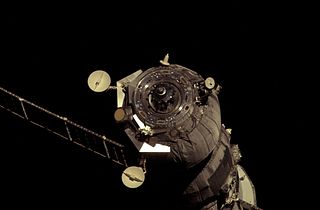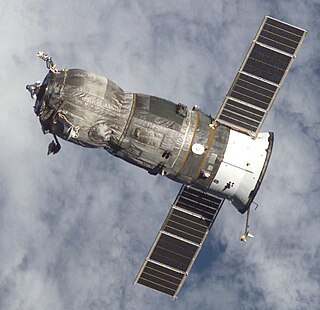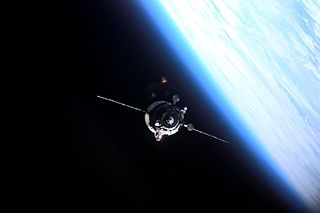Related Research Articles

The year 1967 in spaceflight saw the most orbital launches of the 20th century and more than any other year until 2021, including that of the first Australian satellite, WRESAT, which was launched from the Woomera Test Range atop an American Sparta rocket. The United States National Space Science Data Center catalogued 172 spacecraft placed into orbit by launches which occurred in 1967.
The International Designator, also known as COSPAR ID, is an international identifier assigned to artificial objects in space. It consists of the launch year, a three-digit incrementing launch number of that year and up to a three-letter code representing the sequential identifier of a piece in a launch. In TLE format the first two digits of the year and the dash are dropped.

On 29 March 1974 Mariner 10 became the first spacecraft to fly by Mercury, that saw a spacecraft for the first and last time in the 20th century.

Progress M-59, identified by NASA as Progress 24P, was a Progress spacecraft used to resupply the International Space Station. It was a Progress-M 11F615A55 spacecraft, with the serial number 359.

Progress M-57, identified by NASA as Progress 22P, was a Progress spacecraft used to resupply the International Space Station. It was a Progress-M 11F615A55 spacecraft, with the serial number 357.

Progress M-50, identified by NASA as Progress 15P, was a Progress spacecraft used to resupply the International Space Station. It was a Progress-M 11F615A55 spacecraft, with the serial number 350.

Progress M-47, identified by NASA as Progress 10P, was a Progress spacecraft used to resupply the International Space Station. It was a Progress-M 11F615A55 spacecraft, with the serial number 247.

Progress M1-7, identified by NASA as Progress 6P, was a Progress spacecraft used to resupply the International Space Station. It was a Progress-M1 11F615A55 spacecraft, with the serial number 256.
Progress M1-6, identified by NASA as Progress 4P, was a Progress spacecraft used to resupply the International Space Station. It was a Progress-M1 11F615A55 spacecraft, with the serial number 255.

TDRS-4, known before launch as TDRS-D, is an American communications satellite, of first generation, which was operated by NASA as part of the Tracking and Data Relay Satellite System from 1989 until 2011. It was constructed by TRW, based on a custom satellite bus which was used for all seven of the first generation TDRS satellites.
Kosmos 347, known before launch as DS-P1-Yu No.35, was a Soviet satellite which was launched in 1970 as part of the Dnepropetrovsk Sputnik programme. It was a 250-kilogram (550 lb) spacecraft, which was built by the Yuzhnoye Design Bureau, and was used as a radar calibration target for anti-ballistic missile tests.

Progress M-1, was a Soviet uncrewed cargo spacecraft which was launched in 1989 to resupply the Mir space station. The eighteenth of sixty four Progress spacecraft to visit Mir, it was the first Progress-M spacecraft to be launched, and had the serial number 201. It carried supplies including food, water and oxygen for the Mir EO-5 crew aboard Mir, as well as equipment for conducting scientific research, and fuel for adjusting the station's orbit and performing manoeuvres. At the time of docking, Mir was uncrewed, and remained so until the arrival of the Mir EO-5 crew two weeks later.
Progress M-2, was a Soviet uncrewed cargo spacecraft which was launched in 1989 to resupply the Mir space station. The nineteenth of sixty four Progress spacecraft to visit Mir, it used the Progress-M 11F615A55 configuration, and had the serial number 202. It carried supplies including food, water and oxygen for the EO-5 crew aboard Mir, as well as equipment for conducting scientific research, and fuel for adjusting the station's orbit and performing manoeuvres.
Progress M-7 was a Soviet uncrewed cargo spacecraft which was launched in 1991 to resupply the Mir space station. The twenty-fifth of sixty four Progress spacecraft to visit Mir, it used the Progress-M 11F615A55 configuration, and had the serial number 208. It carried supplies including food, water and oxygen for the EO-8 crew aboard Mir, as well as equipment for conducting scientific research, and fuel for adjusting the station's orbit and performing manoeuvres. It also carried the second VBK-Raduga capsule, intended to return equipment and experiment results to Earth.
Progress M-10 was a Soviet and subsequently Russian uncrewed cargo spacecraft which was launched in 1991 to resupply the Mir space station. The 28th of 64 Progress spacecraft to visit Mir, it used the Progress-M 11F615A55 configuration, and had the serial number 211. It carried supplies including food, water, and oxygen for the EO-10 crew aboard Mir, as well as equipment for conducting scientific research, and fuel for adjusting the station's orbit and performing manoeuvres. It carried the fourth VBK-Raduga capsule, which was used to return experiment results and equipment to Earth when the Progress was deorbited.
Progress M-12 was a Russian uncrewed cargo spacecraft which was launched in 1992 to resupply the Mir space station. The thirtieth of sixty four Progress spacecraft to visit Mir, it used the Progress-M 11F615A55 configuration, and had the serial number 213. It carried supplies including food, water and oxygen for the EO-11 crew aboard Mir, as well as equipment for conducting scientific research, and fuel for adjusting the station's orbit and performing manoeuvres.

Jonathan Christopher McDowell is a British-American astronomer and astrophysicist who works at the Harvard–Smithsonian Center for Astrophysics's Chandra X-ray Center. McDowell is the author and editor of Jonathan's Space Report, an e-mail-distributed newsletter documenting satellite launches.

Kosmos 2501, also known as Glonass-K1 No.12L is a Russian navigation satellite which was launched in 2014. The second Glonass-K satellite to be launched, it is the second of two Glonass-K1 spacecraft which will serve as prototypes for the operational Glonass-K2 spacecraft.
References
- ↑ "Jonathan McDowell / HarvardScience". Harvard University - Harvard Office of News and Public Affairs. Archived from the original on 2012-04-09. Retrieved 2009-02-12.
- ↑ see Archive.org chronology
- ↑ "Space Report No. 1, Jan 30, 1989". Jonathan McDowell. Retrieved 2009-02-12.
- ↑ "Jonathan McDowell's Statement on United States Non-Compliance with UNR1721B". Jonathan McDowell. Retrieved 2009-02-12.